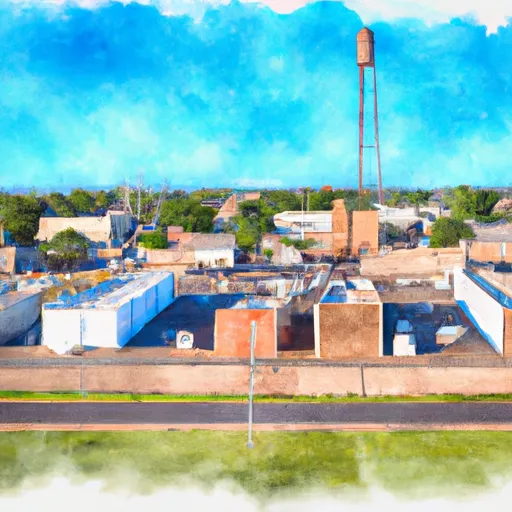-
 Snoflo Premium
Snoflo Premium
Get unlimited access to all our content
With no Ad interruptions! - Start Your Free Trial Login with existing account
Ratliff-City
Eden Index
Climate
9.8
•
Recreation
2.3
•
Community
•
Safeguard
4.7/10

Ratliff-City is a small town located in southern Oklahoma, United States. It experiences a humid subtropical climate, characterized by hot summers and mild winters. Summers are typically hot with temperatures averaging in the high 80s to low 90s Fahrenheit, while winters are relatively mild with temperatures averaging in the 40s to 50s Fahrenheit. The area receives moderate rainfall throughout the year, with the wettest months being May through October.
Hydrologically, Ratliff-City is situated in close proximity to some key water bodies. The town lies near the Washita River, which offers opportunities for fishing, boating, and other water-based activities. Additionally, the Arbuckle-Simpson Aquifer, one of the largest aquifers in Oklahoma, is located in the region. This aquifer not only provides drinking water to numerous communities but also supports various outdoor recreation activities such as swimming, camping, and hiking in the surrounding areas.
In terms of outdoor recreation, Ratliff-City offers several opportunities for nature enthusiasts. The nearby Chickasaw National Recreation Area provides beautiful landscapes, springs, and lakes for visitors to enjoy activities like hiking, picnicking, swimming, and wildlife watching. Moreover, the region is known for its diverse wildlife, making it a popular destination for hunting and birdwatching.
Overall, Ratliff-City, Oklahoma, provides a pleasant climate, access to water bodies, and various outdoor recreation opportunities, making it an appealing destination for nature lovers and outdoor enthusiasts alike.
What is the Eden Index?
The Snoflo Eden Index serves as a comprehensive rating system for regions, evaluating their desirability through a holistic assessment of climate health, outdoor recreation opportunities, and natural disaster risk, acknowledging the profound impact of these factors on livability and well-being.
Climate Health Indicator (CHI): 9.8
Ratliff-City receives approximately
919mm of rain per year,
with humidity levels near 77%
and air temperatures averaging around
17°C.
Ratliff-City has a plant hardyness factor of
7, meaning
plants and agriculture in this region tend to thrive during the non-winter months.
By considering the ideal temperature range, reliable water supplies, clean air, and stable seasonal rain or snowpacks, the Climate Health Indicator (CHI) underscores the significance of a healthy climate as the foundation for quality living.
A healthy climate is paramount for ensuring a high quality of life and livability in a region, fostering both physical well-being and environmental harmony. This can be characterized by ideal temperatures, reliable access to water supplies, clean air, and consistent seasonal rain or snowpacks.
Weather Forecast
Streamflow Conditions
Washita
Area Rivers
Washita
Snowpack Depths
Washita
Reservoir Storage Capacity
Washita
Groundwater Levels
Recreational Opportunity Index (ROI): 2.3
The Recreational Opportunity Index (ROI) recognizes the value of outdoor recreational options, such as parks, hiking trails, camping sites, and fishing spots, while acknowledging that climate plays a pivotal role in ensuring the comfort and consistency of these experiences.
Access to outdoor recreational opportunities, encompassing activities such as parks, hiking, camping, and fishing, is crucial for overall well-being, and the climate plays a pivotal role in enabling and enhancing these experiences, ensuring that individuals can engage in nature-based activities comfortably and consistently.
Camping Areas
| Campground | Campsites | Reservations | Toilets | Showers | Elevation |
|---|---|---|---|---|---|
| Joe Benton Park - Lake Nocona | None | 852 ft | |||
| Weldon Rob Memorial Park - Lake Nocona | 20 | 864 ft | |||
| Tadra Point | 23 | 918 ft | |||
| Boone Park - Lake Nocona | None | 844 ft | |||
| Black Creek Lake | 24 | 947 ft | |||
| Chandler City Park - Purcell | 25 | 1,091 ft | |||
| Tinker AFB Military | None | 1,253 ft | |||
| Fuqua Lake | None | 1,117 ft | |||
| Healdton Municipal Lake | 57 | 900 ft | |||
| Mountain Lake | None | 1,002 ft |
Nearby Fishing
Nearby Ski Areas
Catastrophe Safeguard Index (CSI):
The Catastrophe Safeguard Index (CSI) recognizes that natural disaster risk, encompassing floods, fires, hurricanes, and tornadoes, can drastically affect safety and the overall appeal of an area.
The level of natural disaster risk in a region significantly affects safety and the overall livability, with climate change amplifying these risks by potentially increasing the frequency and intensity of events like floods, fires, hurricanes, and tornadoes, thereby posing substantial challenges to community resilience and well-being.
Community Resilience Indicator (CRI):
The Community Resilience Indicator (CRI) recognizes that education, healthcare, and socioeconomics are crucial to the well-being of a region. The CRI acknowledges the profound impact of these elements on residents' overall quality of life. By evaluating educational resources, healthcare accessibility, and economic inclusivity, the index captures the essential aspects that contribute to a thriving community, fostering resident satisfaction, equity, and social cohesion.

